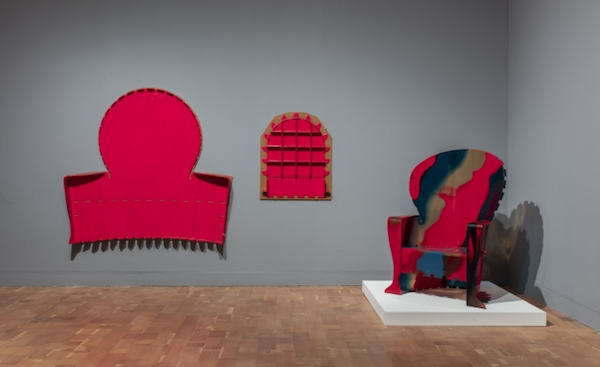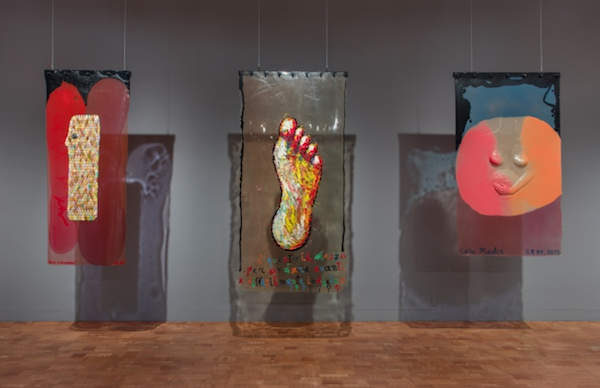[alert type=alert-white ]Please consider making a tax-deductible donation now so we can keep publishing strong voices.[/alert]
International art luminary Gaetano Pesce’s visually provocative Gelati Misti exhibition demonstrates his ability to confront conventions and traverse boundaries. He could be described as artist, architect and designer with considerable achievements in all three areas.
His resin chair below, featured in the MOCA exhibition might be uncomfortable, but it looks great! On seeing it for the first time, “I said that I would like to have one!” He might be willing to accord credit to American “Pop Art” for encouraging him to offer monumentality to pedestrian everyday objects. In reality, he has designed unconventional furniture for Italian and American manufacturers such as Cassini and Knoll International.
Fortunately, I was able to see the video of a lecture that he gave at the Hammer Museum on July 7, 2010.
It provided me with a vivid appreciation of the man, his oeuvre and his genius. This exhibition offers only a fragmented view of his enormous creativity. It would have benefited from more interpretive information; there are three wall labels: “Gelati Misti” – explains the title of the exhibition,”Industrial Skins” and “Vases”, the two categories of objects on display. All of these objects are created from industrial resins which offer virtually unlimited plasticity with accompanying color variations allowing configurations from the flat surfaces of the chair above to the sinuous vases below. He has also managed to use resins to create flat two dimensional objects that simulate paintings – calling them “Industrial Skins.”
Pesce’s history of working with industrial resins spans almost fifty years. As an apprentice at the Moretti, Vistas and Venini glass works in Murano, Venice, he learned to manipulate molten glass with all of its variations in color into coherent three dimensional objects. He has managed to transfer those methodologies using industrial resins that allow him to create thousands of objects in a bewildering diversity of shape, color and texture. Among them is a spaghetti bracelet available for sale at the gallery.
He is an artist, like Marcel Duchamp, who does not adhere to the sanctity of his creations. Once in response to a collector who lamented that one of his glass sculptures had been cracked in shipping, Duchamp stated, “That improves it.” Similarly, following the Hammer Museum lecture, a member of the audience lamented that her young daughter had disfigured the surface of one of his tables. Pesce responded, “That improves it.”
“MOCA: Gaetano Pesce Exhibition Stumbles Across a Bright Ethical Line” — This headline accompanied LA Times art critic Christopher Wright’s October 3, 2016 review of “Gaetano Pesce: Molds (Gelati Misti) at MOCA’s Pacific Design Center branch. So, what else is new at MOCA? Jeffrey Deitch, the previous director, was castigated for having guest curators for his Geffen MOCA “Art in the Streets” exhibition when these guest curators were known to have direct financial interest in the work of several participating graffiti artists included the exhibition. Deitch was an imaginative and enterprising New York art dealer who accepted the challenge of reinvigorating MOCA. The current MOCA director, Philippe Vergne, is a credentialed curator who was director of the New York Dia Art Foundation for six years. Verne is now criticized for hosting an exhibition where its guest curator is the owner of 34 of 39 objects on display.
To say the least, this is a highly unprincipled act in the American art museum profession. It is customary for art museums to present exhibitions of private collections; however, in such cases a member of the museum staff serves as curator, making selections from the private collection. It is a well-known fact that museum exhibitions enhance both the prestige and monetary value of displayed objects. Christopher Wright states that, in this case, ethical standards have been violated.
On the website of the Association of Art Museum Directors section devoted to “A Code of Ethics for Art Museum Directors,” it states, “The position of the museum director is one of trust. The director should act with integrity and in accordance with the highest ethical principles. The director should avoid any and all activities that could compromise his or her position or the institution…AAMD members who violate this code of ethics will be subject to discipline by reprimand, suspension, or expulsion from the AAMD. Infractions by any art museum may expose that institution to censure and /or sanctions, as determined by the Board of Trustees of the AAMD, that may, in the case of sanctions, include, without limitation, suspension of loans and shared exhibitions between the sanctioned museum and museums of which the AAMD members are directors.”
Obviously harsh language; however, it reflects the standards of the art museum directors’ profession. When interrogated by Christopher Wright discussing the exhibition’s reliance on one private collection, Verne said, “It’s a legitimate concern.” He continued. “I understand it’s unusual.” Verne said that identifying the collector as co-organizer was “perhaps clumsy.” He further stated that “I wanted to be transparent.”
Does this add up to cause for professional discipline? That will be a decision to be made by MOCA’a board of trustees and the Association of Art Museum Directors. However, for myself, I find this to be another example of Verne’s perplexing professional standards. Three years ago, I went to see an exhibition presented in a New York South Bronx public housing project sponsored by the Dia Art Foundation of which Verne was then the director. Although it was highly praised by The New Yorker’s art critic and occasioned hundreds of Manhattan’s cultural cognoscenti to take the subway to a world with which they had no familiarity, I found it to be a blatant insulting act of cultural imperialism perpetrated on Bronx residents by an elitist Manhattan art institution. I wrote about my dissatisfaction on my blog, “The Cosmopolitan Observer.”
Some parallels can be drawn between the MOCA Pesce exhibition and Dia’s invasion of the South Bronx. In both cases, Verne was the museum director responsible for establishing policies to be executed by others. I quote briefly from my blog post.
“On a Saturday afternoon in mid-September (2013), we took the #5 subway to Prospect Avenue in the South Bronx and proceeded to walk North on Prospect Avenue to 163rd Street. After crossing Union Avenue, we turned right on Tinton Avenue and gained access to Forest Houses, a Post World War II public housing project.
“So, what did we find? I would describe the ramshackle wooden structures that appeared to be the core of the project as an insensitive intrusion into the courtyard of a low-income public housing project. There was a library, radio station and a bank of computers linked to the internet. Where and how did Gramsci (an Italian communist philosopher of the early twentieth century who appeared to be the focus of the project) fit into this mess? Searching for some documentation, I found a faded typed biography.
“Was this a bad joke? No, this was supposed to be a serious work of art. As I wandered from one tacky space to the next, I tried to image who was the so-called artist who had conceived of this entity and why it was sponsored by the Dia Art Foundation. Beyond that, I was compelled to ask what it had to do with Antonio Gramsci?
“As we wandered around this desultory organized phenomenon, we came upon an open-air theater with about two hundred mostly middle-aged Caucasians seated in a semi-circle listening to an African-American man promote his book describing his experiences with the ANC (African National Congress) in South Africa. It did not appear that many, if any, project residents were in the audience.”
Could one say that this South Bronx Dia Art Foundation invasion was an act of questionable ethical practice? I believe that the evidence speaks for itself as does the evidence regarding MOCA’s Design Center Pesce exhibition. What does this tell us about Philippe Vergne? Obviously, they are products of a museum director who dances warily along the boundary of ethical behavior.
Top image: Installation view of Gaetano Pesce: Molds (Gelati Misti), September 3–November 27, 2016 at MOCA Pacific Design Center, courtesy of The Museum of Contemporary Art, Los Angeles, photo by Brian Forrest
Our critic Allon Schoener has been: Director, Cincinnati Contemporary Art Center; Consultant, The Library of Congress; Guest Curator, The Metropolitan Museum of Art; Director, Museum Aid Program, New York State Council on the Arts; Curator, San Francisco Museum of Art; Guest Curator and consultant, Smithsonian Institution; Assistant Director,The Jewish Museum, New York; Project Curator, United Nations Vienna Center.
